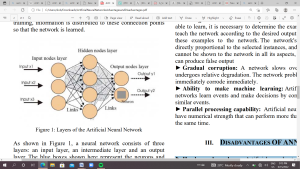Artificial Neural Networks Seminar Report PDF Download
CHAPTER ONE
1.1 INTRODUCTION
Bhadeshia H. (2019). Artificial neural networks are the modeling of the human brain with the simplest definition and building blocks are neurons. There are about 100 billion neurons in the human brain. Each neuron has a connection point between 1,000 and 100,000. In the human brain, information is stored in such a way as to be distributed, and we can extract more than one piece of this information when necessary from our memory in parallel. We are not mistaken when we say that a human brain is made up of thousands of very, very powerful parallel processors. In multi-layer artificial neural networks, there are also neurons placed in a similar manner to the human brain. Each neuron is connected to other neurons with certain coefficients. During training, information is distributed to these connection points so that the network is learned.most advanced supercomputers.
The simplest definition of a neural network, more properly referred to as an ‘artificial’ neural network (ANN), is provided by the inventor of one of the first neurocomputers, Dr. Robert Hecht-Nielsen. He defines a neural network as: a computing system made up of a number of simple, highly interconnected processing elements, which process information by their dynamic state response to external inputs. ANNs are processing devices (algorithms or actual hardware) that are loosely modeled after the neuronal structure of the mamalian cerebral cortex but on much smaller scales. A large ANN might have hundreds or thousands of processor units, whereas a mamalian brain has billions of neurons with a corresponding increase in magnitude of their overall interaction and emergent behavior. Although ANN researchers are generally not concerned with whether their networks accurately resemble biological systems, some have. For example, researchers have accurately simulated the function of the retina and modeled the eye rather well (Egmont-Petersen, 2020).
1.2 Background of Artificial Neural Network (ANN)
An Artificial Neural Network (ANN) is an information processing paradigm that is inspired by the way biological nervous systems, such as the brain, process information. The key element of this paradigm is the novel structure of the information processing system. It is composed of a large number of highly interconnected processing elements (neurones) working in unison to solve specific problems. ANNs, like people, learn by example. An ANN is configured for a specific application, such as pattern recognition or data classification, through a learning process. Learning in biological systems involves adjustments to the synaptic connections that exist between the neurones. This is true of ANNs as well (Bishop and Christopher, 2015).
Artificial Neural Networks contain artificial neurons which are called units. These units are arranged in a series of layers that together constitute the whole Artificial Neural Networks in a system. A layer can have only a dozen units or millions of units as this depends on the complexity of the system. Commonly, Artificial Neural Network has an input layer, output layer as well as hidden layers. The input layer receives data from the outside world which the neural network needs to analyze or learn about. Then this data passes through one or multiple hidden layers that transform the input into data that is valuable for the output layer. Finally, the output layer provides an output in the form of a response of the Artificial Neural Networks to input data provided (Borgelt and Christian, 2018).
In the majority of neural networks, units are interconnected from one layer to another. Each of these connections has weights that determine the influence of one unit on another unit. As the data transfers from one unit to another, the neural network learns more and more about the data which eventually results in an output from the output layer.
1.3 Advantages of Artificial Neural Network (ANN)
- Storing information on the entire network: Information such as in traditional programming is stored on the entire network, not on a database. The disappearance of a few pieces of information in one place does not prevent the network from functioning.
- Ability to work with incomplete knowledge: After ANN training, the data may produce output even with incomplete information. The loss of performance here depends on the importance of the missing information.
- Having fault tolerance: Corruption of one or more cells of ANN does not prevent it from generating output. This feature makes the networks fault tolerant.
- Having a distributed memory: In order for ANN to be able to learn, it is necessary to determine the examples and to teach the network according to the desired output by showing these examples to the network. The network’s success is directly proportional to the selected instances, and if the event cannot be shown to the network in all its aspects, the network can produce false output
- Gradual corruption: A network slows over time and undergoes relative degradation. The network problem does not immediately corrode immediately.
- Ability to make machine learning: Artificial neural networks learn events and make decisions by commenting on similar events.
- Parallel processing capability: Artificial neural networks have numerical strength that can perform more than one job at the same time.
1.4 Disadvantages of Artificial Neural Network (Ann)
- Hardware dependence: Artificial neural networks require processors with parallel processing power, in accordance with their structure. For this reason, the realization of the equipment is dependent.
- Unexplained behavior of the network: This is the most important problem of ANN. When ANN produces a probing solution, it does not give a clue as to why and how. This reduces trust in the network.
- Determination of proper network structure: There is no specific rule for determining the structure of artificial neural networks. Appropriate network structure is achieved through experience and trial and error.
- Difficulty of showing the problem to the network: ANNs can work with numerical information. Problems have to be translated into numerical values before being introduced to ANN. The display mechanism to be determined here will directly influence the performance of the network. This depends on the user’s ability.
- The duration of the network is unknown: The network is reduced to a certain value of the error on the sample means that the training has been completed. This value does not give us optimum results.
Science artificial neural networks that have stepped into the world in the mid-20th century are rapidly developing. In our present day, we have examined the advantages of artificial neural networks and the problems encountered in the course of their use. It should not be forgotten that the disadvantages of ANN networks, which are a developing science branch, are eliminated one by one and their advantages are increasing day by day. This means that artificial neural networks will become an indispensable part of our lives increasingly important (Cybenko, 2016).
DOWNLOAD COMPLETE WORK- For Reference Only: Materials are for research, citation, and idea generation purposes and not for submission as your original final year project work.
- Avoid Plagiarism: Do not copy or submit this content as your own project. Doing so may result in academic consequences.
- Use as a Framework: This complete project research material should guide the development of your own final year project work.
- Academic Access: This platform is designed to reduce the stress of visiting school libraries by providing easy access to research materials.
- Institutional Support: Tertiary institutions encourage the review of previous academic works such as journals and theses.
- Open Education: The site is maintained through paid subscriptions to continue offering open access educational resources.







